- Coaches (3)
- Courses (25)
- Customer Success (10)
- Investment & Fundraising (6)
- Management & Leadership (34)
- Marketing (6)
- Prospecting (19)
- Sales (34)
- Sales Impact Academy News (23)
- Wellbeing (9)
Prioritization and Sequencing — How to Avoid Common Mistakes in a Startup?

- Courses, Prospecting, Sales
- Simone McNichols-Thomas
- Estimated Reading Time: 9 minutes
Sales experts say there is a golden solution to the problems we encounter when undertaking one of the most common tasks in the industry — prioritization and sequencing.
We had a chat with SDR leader, Sam Nelson, and Manager of Sales Development, Ken Amar, of Outreach, about how to use prioritization and sequencing strategy to get more qualified opportunities. Every. Single. SDR team wants to maximize the effectiveness of their daily touchpoint numbers. Sam and Ken seek to meet this need by sharing good practices for prioritizing your prospects and scheduling your outbound communication.
The two sales experts stressed that bad prioritization of prospects leads to time being focused in the wrong places. This buries sales teams in the prioritization ‘death spiral’. Managers may then fall back on whatever is measurable as a reason for poor performance. For example, if they have a poor conversion rate from 100 calls a day, it must be that you’re doing terribly on the phones, right?…
Perhaps not!
The problem may be you’re just calling the wrong people. This is why prioritizing accounts well is key.
Here’s a brief overview of Sam and Ken’s top tips to conquer prioritization and sequencing:
1. Deciding which accounts to prioritize.
Start by asking yourself, “Who is most likely to buy and be a good customer right now?”
Take the time to understand the likely priorities for your main prospects. One way to do this is to consider running campaigns for your competitor’s customers. Look at who is buying from your competition and their current market behavior. This will give you insight into whether they will buy from you.
2. Prioritising prospects within an account.
Make a matrix that defines prospect titles and breaks them into tiers of likely engagement. This is especially important if you are working with people who don’t have much SDR experience.
First, figure out which departments you sell into and organize them in hierarchical order from most to least important.
Next, input job titles under each respective department and arrange them into tiers from ‘high priority’ to ‘no priority’.
- High priority 🟢 = A prospect that can become an immediate opportunity.
- Lower priority 🟡 = A prospect that can get you closer to an immediate opportunity.
- No priority 🔴 = These are people you do not touch.
When you’re finished, this is what your matrix should look like…
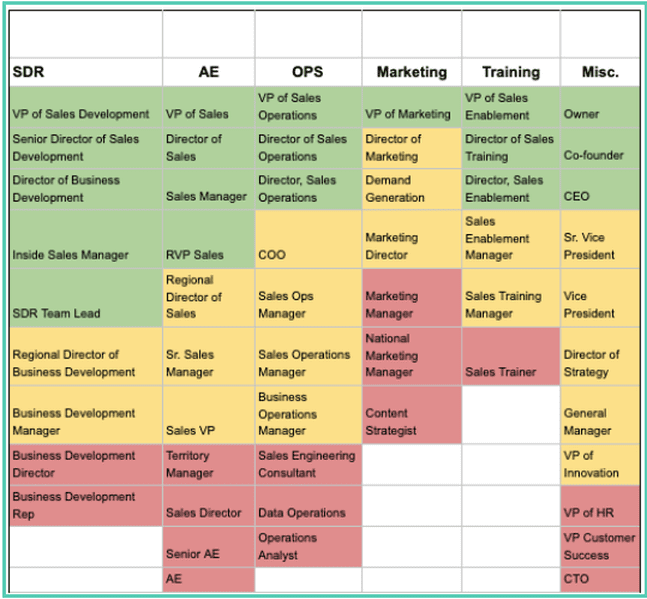
To find out more about this, check out Sam Nelson’s The Agoge Playbook or visit our on demand content with him on ‘The Agoge Sequence… Getting in front of high-priority prospects’
3. Steps for a perfect outbound sequence strategy for high priority prospects
Sam and Ken swear by The Agoge Sequence! It lays out the number of touch points to have with a prospect before giving up, and utilises the ‘triple touch’ approach-this is when you email, connect on social and call your prospect, all within the first day. Make an entrance because public enemy number one is being ignored!
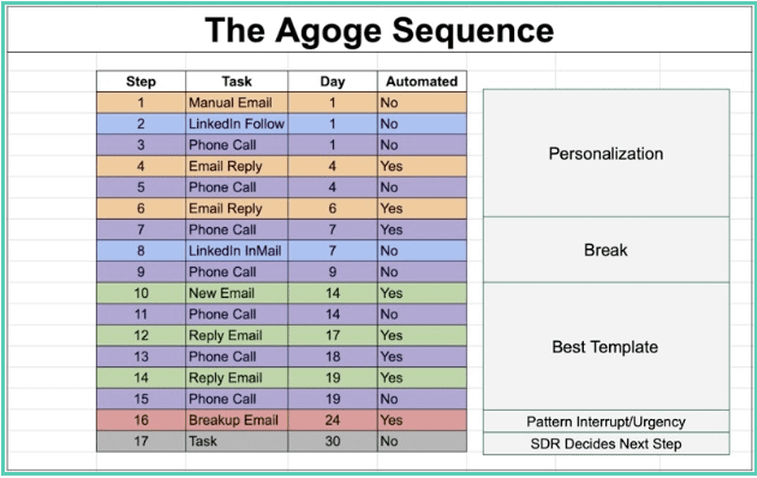
As shown in peach, your manual emails for high-priority prospects should always be personalized. Try to build that one-to-one dialogue by using the word ‘I’ in the first sentence and avoid sounding like a robot.
You should have an automated schedule of personalized replies ready for day four and six, in case you don’t get a response to your initial email. Remember, these replies are to draw attention to the first email, so they must be short. When done right, replies usually get a better response rate than the first email.
For the automated email stage of the sequence (shown in green), A/B test your templates and choose the one that works best. If you don’t receive a response to your first email, be sure to ask if you’re speaking to the right person in your reply email. This helps to entice a response.
Break Up Emails are your last attempt at contact and an opportunity to be more risky. You can try being unexpectedly direct or perhaps incorporate some humor. Have fun with it — you’re speaking human-to-human after all!
4. How to handle the outbound sequence for low priority prospects
For low priority prospects use a stripped back Agoge sequence like the one shown below:
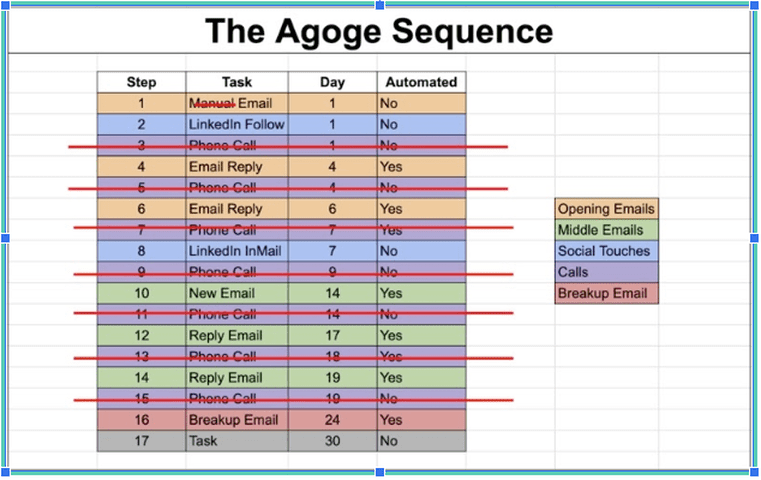
This sequence cuts out the time-consuming parts, like phone calls, so you can focus most of your effort on high priority prospects.
With both high and low priority prospects, be sure to monitor your load balance to maintain consistent activity. Add a maximum of 15–20 people per day into the sequence — these should generally be your high priority prospects. If you include more than this on any given day, you’ll end up with wacky spikes in activity. Being inconsistent in inputting prospects means one day you’ll have 100 phone calls to make, and the next you will have zero touchpoints scheduled.
5. What is a referral sequence strategy?
Sam and Ken’s famous referral strategy achieves a reply rate of a whopping 54%! To achieve this in your own team, ALWAYS ask for a referral if you ever get this response: “Hey I’m not your guy.”
Input the referred person into the referral sequence, referencing the person who referred them in the email. This saves you time and is very effective.
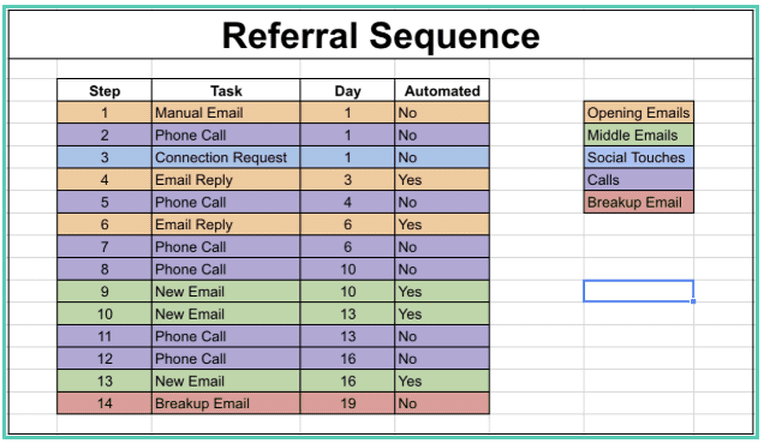
6. What about best practices for follow-ups?
Have you ever sent an email and someone responds with, “Get back to me in three months”?
Try using FUPS, AKA the Follow-Up Sequence. At Outreach, SDR’s who did this well secured most of their opportunities six months down the line, by using this method.
First, you reply to the prospect’s email there and then, but you schedule the reply to be sent a few months into the future. You then attach the FUP to the reply to create your sequence. This will cue up your future touchpoints i.e. calls. The sequence will spring into life in the event your prospect doesn’t engage with your reply. It’s pretty easy to install a FUP sequence into your process and you’re twice as likely to get a response.
You can also choose to use this sequence in the present. Just skip the step where you schedule the reply to be sent in the future.
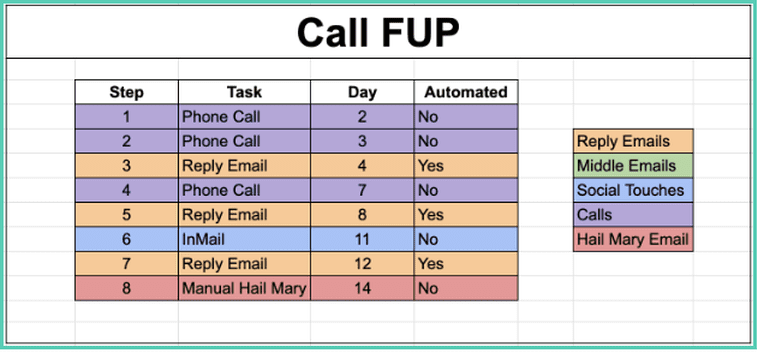
It won’t get you immediate results as your touch points are delayed, but the long term benefits are immense. The sequence allows you to be consistent and disciplined with minimal effort.
So, if you are a SDR reading this, embrace the data and inform your prioritization of outbound leads! Couple that with a solid sequence and you’re on the road to success.
Sam Nelson is a Coach at Sales impact Academy and teaches our Prospecting Through Sequences course 08:00am PT | 11:00am ET | 04:00pm UK. Find out more here.









